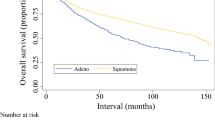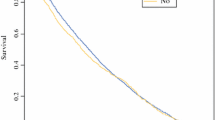Abstract
Purpose
Anal adenocarcinoma (AAC) is a rare disease with treatment protocols that mimic both that of rectal adenocarcinoma (RAC) and anal squamous cell carcinoma (ASCC). Due to its rarity, data regarding outcomes are lacking. We sought to determine outcomes of patients with AAC compared to RAC and ASCC and to evaluate risk factors for mortality in AAC.
Methods
The United States’ National Cancer Database was queried for all adult patients presenting with nonmetastatic AAC, RAC, or ASCC from 2003 to 2011. The primary outcome was overall survival. Intergroup univariate comparisons, unadjusted Kaplan-Meier, and multivariable Cox proportional hazards modeling were used to compare outcomes between AAC, RAC, and ASCC and to identify factors associated with survival within AAC.
Results
The query identified 129,153 patients (N = 2117 AAC, 19,427 ASC, 107,609 RAC). AAC patients were less likely than RAC patients to have surgery (72.5 vs. 87.1%), and also less likely to receive chemotherapy (54.7% vs. 96.1%) and radiation (58.2% vs. 74.1%) than patients with ASCC (all p < 0.001). Overall median survival in AAC was 65 months compared to 109 months for RAC and > 120 months for ASCC. On multivariable analysis, independent treatment-related predictors of decreased mortality hazard in AAC included proctectomy (hazard ratio [HR], 0.66) and chemotherapy (HR, 0.60) (both p < 0.001).
Conclusion
AAC tumors have worse prognosis than either RAC or ASCC. Within patients with AAC, nonsurgical management was independently associated with increased mortality hazard. Patients with AAC should be evaluated in a multidisciplinary setting and referred for surgery.




Similar content being viewed by others
References
Siegel RL, Miller KD, Jemal A (2018) Cancer statistics, 2018. CA Cancer J Clin 68(1):7–30. https://doi.org/10.3322/caac.21442
Leonard D, Beddy D, Dozois EJ (2011) Neoplasms of anal canal and perianal skin. Clin Colon Rectal Surg 24(1):54–63. https://doi.org/10.1055/s-0031-1272824
Stewart DB, Gaertner WB, Glasgow SC, Herzig DO, Feingold D, Steele SR, Prepared on Behalf of the Clinical Practice Guidelines Committee of the American Society of C, Rectal S (2018) The American society of colon and rectal surgeons clinical practice guidelines for anal squamous cell cancers (revised 2018). Dis Colon rectum 61(7):755–774. https://doi.org/10.1097/DCR.0000000000001114
Monson JR, Weiser MR, Buie WD, Chang GJ, Rafferty JF, Buie WD, Rafferty J, Standards Practice Task Force of the American Society of C, Rectal S (2013) Practice parameters for the management of rectal cancer (revised). Dis Colon rectum 56(5):535–550. https://doi.org/10.1097/DCR.0b013e31828cb66c
Chang GJ, Gonzalez RJ, Skibber JM, Eng C, Das P, Rodriguez-Bigas MA (2009) A twenty-year experience with adenocarcinoma of the anal canal. Dis Colon rectum 52(8):1375–1380. https://doi.org/10.1007/DCR.0b013e3181a79589
Beal KP, Wong D, Guillem JG, Paty PB, Saltz LL, Wagman R, Minsky BD (2003) Primary adenocarcinoma of the anus treated with combined modality therapy. Dis Colon rectum 46(10):1320–1324. https://doi.org/10.1097/01.DCR.0000089116.17611.07
Bertelson N, Blumetti J, Cintron J, Harrison J, Chaudhry V, Abcarian H (2015) Anal adenocarcinoma: outcomes in an uncommon malignancy. Am Surg 81(11):1114–1117
Bilimoria KY, Stewart AK, Winchester DP, Ko CY (2008) The National Cancer Data Base: a powerful initiative to improve cancer care in the United States. Ann Surg Oncol 15(3):683–690. https://doi.org/10.1245/s10434-007-9747-3
Raval MV, Bilimoria KY, Stewart AK, Bentrem DJ, Ko CY (2009) Using the NCDB for cancer care improvement: an introduction to available quality assessment tools. J Surg Oncol 99(8):488–490. https://doi.org/10.1002/jso.21173
Franklin RA, Giri S, Valasareddy P, Lands LT, Martin MG (2016) Comparative survival of patients with anal adenocarcinoma, squamous cell carcinoma of the anus, and rectal adenocarcinoma. Clin Colorectal Cancer 15(1):47–53. https://doi.org/10.1016/j.clcc.2015.07.007
Kounalakis N, Artinyan A, Smith D, Mojica-Manoso P, Paz B, Lai LL (2009) Abdominal perineal resection improves survival for nonmetastatic adenocarcinoma of the anal canal. Ann Surg Oncol 16(5):1310–1315. https://doi.org/10.1245/s10434-009-0392-x
Klas JV, Rothenberger DA, Wong WD, Madoff RD (1999) Malignant tumors of the anal canal: the spectrum of disease, treatment, and outcomes. Cancer 85(8):1686–1693
Papagikos M, Crane CH, Skibber J, Janjan NA, Feig B, Rodriguez-Bigas MA, Hung A, Wolff RA, Delclos M, Lin E, Cleary K (2003) Chemoradiation for adenocarcinoma of the anus. Int J Radiat Oncol Biol Phys 55(3):669–678
Joon DL, Chao MW, Ngan SY, Joon ML, Guiney MJ (1999) Primary adenocarcinoma of the anus: a retrospective analysis. Int J Radiat Oncol Biol Phys 45(5):1199–1205
Belkacemi Y, Berger C, Poortmans P, Piel G, Zouhair A, Meric JB, Nguyen TD, Krengli M, Behrensmeier F, Allal A, De Looze D, Bernier J, Scandolaro L, Mirimanoff RO, Rare Cancer N (2003) Management of primary anal canal adenocarcinoma: a large retrospective study from the Rare Cancer Network. Int J Radiat Oncol Biol Phys 56(5):1274–1283
Longo WE, Vernava AM 3rd, Wade TP, Coplin MA, Virgo KS, Johnson FE (1995) Rare anal canal cancers in the U.S. veteran: patterns of disease and results of treatment. Am Surg 61(6):495–500
Acknowledgments
The NCDB is a joint project of the Commission on Cancer of the American College of Surgeons and the American Cancer Society. The data used in the study are derived from a de-identified NCDB participant user file. The American College of Surgeons and the Commission on Cancer have not verified and are not responsible for the analytic or statistical methods or the conclusions drawn from these data by the investigators.
Grant support
This work has been supported indirectly by the Mayo Clinic Robert D. and Patricia E. Kern Center for the Science of Health Care Delivery and by the Mayo School of Graduate Medical Education Clinician Investigator program. No specific grant number is associated with the work.
Author information
Authors and Affiliations
Corresponding author
Ethics declarations
Conflict of interest
The authors declare that they have no conflicts of interest.
Additional information
Publisher’s Note
Springer Nature remains neutral with regard to jurisdictional claims in published maps and institutional affiliations.
Rights and permissions
About this article
Cite this article
McKenna, N.P., Bergquist, J.R., Habermann, E.B. et al. Surgery and chemotherapy are associated with improved overall survival in anal adenocarcinoma: results of a national cohort study. Int J Colorectal Dis 34, 607–612 (2019). https://doi.org/10.1007/s00384-018-03232-8
Accepted:
Published:
Issue Date:
DOI: https://doi.org/10.1007/s00384-018-03232-8




